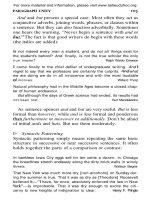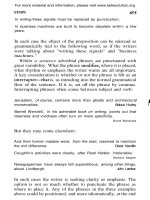Tài liệu Essential guide to writing part 1 ppt
Bạn đang xem bản rút gọn của tài liệu. Xem và tải ngay bản đầy đủ của tài liệu tại đây (380.8 KB, 15 trang )
For more material and information, please visit www.tailieuduhoc.org
For more material and information, please visit www.tailieuduhoc.org
For more material and information, please visit www.tailieuduhoc.org
Thomas S. Kane
For more material and information, please visit www.tailieuduhoc.org
If you purchased this book without a cover, you should be aware that this book is
stolen property. It was reported as "unsold and destroyed" to the publisher, and
neither the author nor the publisher has received any payments for this
"stripped book."
For more material and information, please visit www.tailieuduhoc.org
Acknowledgments
This book is based on The Oxford Guide to Writing: A Rhet-
oric and Handbook for College Students, and thanks are due
once more to those who contributed to that book: my friend
and colleague Leonard J. Peters; Professors Miriam Baker of
Dowling College, David Hamilton of the University of Iowa,
Robert Lyons and Sandra Schor of Queens College of the
City University of New York, and Joseph Trimmer of Ball
State University, all of whom read the manuscript and con-
tributed perceptive comments; Ms. Cheryl Kupper, who
copyedited that text with great thoroughness and care; and
John W. Wright, my editor at the Oxford University Press.
For the present edition I am again grateful to Professor
Leonard J. Peters and to John W. Wright. In addition I wish
to thank William P. Sisler and Joan Bossert, my editors at
Oxford University Press, who encouraged, criticized, and im-
proved, as good editors do.
Kittery Point, Maine T.S.K.
December 1987
For more material and information, please visit www.tailieuduhoc.org
Contents
Introduction 3
1. Subject, Reader, and Kinds of Writing 5
2. Strategy and Style 9
3. Grammar, Usage, and Mechanics
13
PART 1 The Writing Process
4. Looking for Subjects 19
5. Exploring for Topics 23
6. Making a Plan 29
7. Drafts and Revisions 34
17
PART II.
8.
9.
10.
11.
The Essay 43
Beginning 45
Closing 60
Organizing the Middle
Point of View, Persona,
67
and Tone
74
PART 3 The Expository Paragraph 87
12. Basic Structure 89
13. Paragraph Unity 95
14. Paragraph Development: (1) Illustration and
Restatement 106
For more material and information, please visit www.tailieuduhoc.org
8
CONTENTS
15. Paragraph Development: (2) Comparison, Contrast,
and Analogy 114
16. Paragraph Development: (3) Cause and Effect 125
17. Paragraph Development: (4) Definition, Analysis,
and Qualification 132
PART 4. The Sentence 149
18. The Sentence: A Definition 151
19. Sentence Styles 161
20. The Well-Written Sentence: (1) Concision 191
21. The
Well-Written
Sentence: (2) Emphasis 200
22. The Well-Written Sentence: (3) Rhythm 223
23. The Well-Written Sentence: (4) Variety 234
PART v. Diction 241
24. Meaning 243
25. Clarity and Simplicity 262
26. Concision 281
27. Figurative Language 295
28. Unusual Words and Collocations 325
29. Improving Your Vocabulary: Dictionaries 336
PART
vi.
Description and Narration 349
30. Description 351
31. Narration 366
PART
VII.
Punctuation 377
Introduction 379
32. Stops 383
33. The Other Marks 417
Name Index 439
Subject Index 445
For more material and information, please visit www.tailieuduhoc.org
The New Oxford Guide
to Writing
For more material and information, please visit www.tailieuduhoc.org
Introduction
Two broad assumptions underlie this book: (1) that writing
is a rational activity, and (2) that it is a valuable activity.
To say that writing is rational means nothing more than
that it is an exercise of mind requiring the mastery of tech-
niques anyone can learn. Obviously, there are limits: one can-
not learn to write like Shakespeare or Charles Dickens. You
can't become a genius by reading a book.
But you don't have to be a genius to write clear, effective
English. You just have to understand what writing involves
and to know how to handle words and sentences and para-
graphs. That you can learn. If you do, you can communicate
what you want to communicate in words other people can
understand. This book will help by showing you what good
writers do.
The second assumption is that writing is worth learning. It
is of immediate practical
benefit
in almost any job or career.
Certainly there are many jobs in which you can get along
without being able to write clearly. If you know how to write,
however, you will get along faster and farther.
There is another, more profound value to writing. We cre-
ate ourselves by words. Before we are businesspeople or law-
yers or engineers or teachers, we are human beings. Our
For more material and information, please visit www.tailieuduhoc.org
INTRODUCTION
growth as human beings depends on our capacity to under-
stand and to use language. Writing is a way of growing. No
one would argue that being able to write will make you mor-
ally better. But it will make you more complex and more
interesting—in
a word, more human.
For more material and information, please visit www.tailieuduhoc.org
CHAPTER
1
Subject, Reader,
and Kinds of Writing
Choosing a
Subject
Often, of course, you are not free to choose at all. You must
compose a report for a business meeting or write on an as-
signed topic for an English class. The problem then becomes
not what to write about but how to attack it, a question we'll
discuss in Chapters 5 and 6.
When you can select a subject for yourself, it ought to in-
terest you, and interest others as well, at least potentially. It
should be within the range of your experience and skill,
though it is best if it stretches you. It ought to be neither so
vast that no one person can encompass it nor so narrow and
trivial that no one cares.
Don't be afraid to express your own opinions and feelings.
You are a vital part of the subject. No matter what the topic,
you are really writing about how you understand it, how you
feel about it. Good writing has personality. Readers enjoy
sensing a mind at work, hearing a clear voice, responding to
an unusual sensibility. If you have chosen a topic that is of
general concern, and if genuine feeling and intelligence come
through, you will be interesting. Interest lies not so much in
a topic as in what a writer has made of it.
For more material and information, please visit www.tailieuduhoc.org
6 INTRODUCTION
About Readers
You don't want to repel readers. This doesn't mean you have
to flatter them or avoid saying something they may disagree
with. It does mean you must respect them. Don't take their
interest for granted or suppose that it is the readers' job to
follow you. It's your job to guide them, to make their task as
easy as the subject allows.
Ask yourself questions about your readers: What can I ex-
pect them to know and not know? What do they believe and
value? How do I want to affect them by what I say? What
attitudes and claims will meet with their approval? What will
offend them? What objections may they have to my ideas,
and how can I anticipate and counter those objections?
Readers may be annoyed if you overestimate their knowl-
edge. Tossing off unusual words may seem a put-down, a way
of saying, "I know more than you." On the other hand, la-
boring the obvious also implies a low opinion of readers:
don't tell them what a wheel is; they know. It isn't easy to
gauge your
readers'
level of knowledge or to sense their be-
liefs and values. Sensitivity to readers comes only with ex-
perience, and then imperfectly. Tact and respect, however, go
a long way. Readers have egos too.
Kinds of Writing
The various effects a writer may wish to have on his or her
readers—to
inform, to persuade, to
entertain—result
in dif-
ferent kinds of prose. The most common is prose that in-
forms, which, depending on what it is about, is called
exposition, description, or narration.
Exposition explains. How things
work—an
internal com-
bustion engine.
Ideas—a
theory of economics. Facts of every-
day
life—how
many people get divorced.
History—why
Custer attacked at the Little Big Horn. Controversial issues
laden with
feelings—abortion,
politics, religion. But whatever
For more material and information, please visit www.tailieuduhoc.org
SUBJECT, READER, AND KINDS OF WRITING
7
its subject, exposition reveals what a particular mind thinks
or knows or believes. Exposition is constructed logically. It
organizes around cause/effect, true/false, less/more, positive/
negative, general/particular, assertion/denial. Its movement is
signaled by connectives like therefore, however, and so, be-
sides, but, not only, more important, in fact, for example.
Description deals with
perceptions—most
commonly visual
perceptions. Its central problem is to arrange what we see into
a
significant
pattern. Unlike the logic of exposition, the pat-
tern is spatial: above/below, before/behind, right/left, and so
on.
The subject of narration is a series of related
events—a
story. Its problem is twofold: to arrange the events in a se-
quence of time and to reveal their significance.
Persuasion seeks to alter how readers think or believe. It is
usually about controversial topics and often appeals to reason
in the form of argument, offering evidence or logical proof.
Another form of persuasion is satire, which ridicules folly or
evil, sometimes subtly, sometimes crudely and coarsely. Fi-
nally, persuasion may be in the form of eloquence, appealing
to ideals and noble sentiments.
Writing that is primarily entertaining includes fiction, per-
sonal essays, sketches. Such prose will receive less attention
here. It is certainly important, but it is more remote from
everyday needs than exposition or persuasion.
For Practice
> List ten or twelve topics you might develop into a short essay.
Think of topics that deal not so much with things, places, or how-to-
do projects as with your opinions and beliefs. Pick subjects that
interest you and are within your experience, yet challenging. Be
specific: don't simply write "my job" but something like "what
I
like most (or hate most) about my job."
£>
Selecting one of the topics on your list, compose a paragraph
about the readers for whom you might develop it. Consider how
For more material and information, please visit www.tailieuduhoc.org









